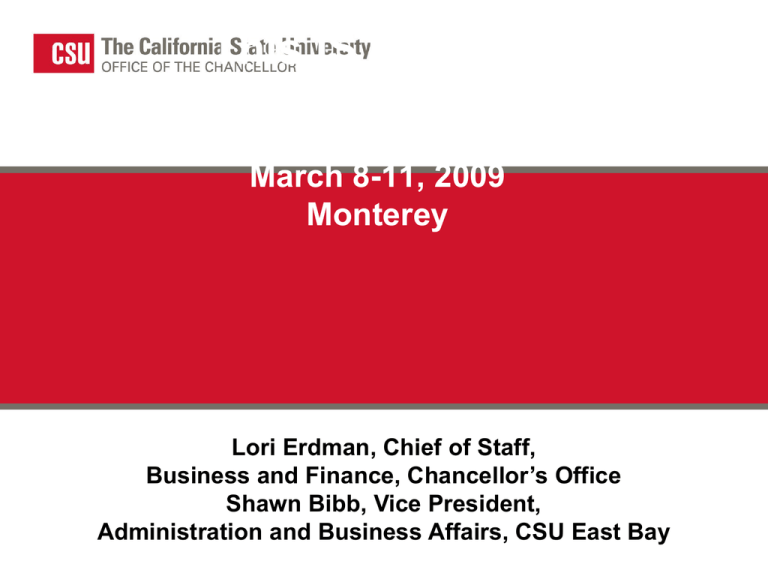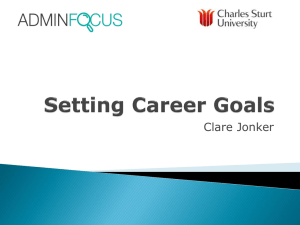This is the CSU - Financial Officers' Association
advertisement

This IS the CSU CSU 101 March 8-11, 2009 Monterey Lori Erdman, Chief of Staff, Business and Finance, Chancellor’s Office Shawn Bibb, Vice President, Administration and Business Affairs, CSU East Bay Higher Education in the State of California State Government and Agencies Facts about the California State University Comparing CSU to other Institutions How the CSU is Organized and Governed Policies, Advice and Where We Go From Here CSU 101 This IS the CSU Mar. 8-11, 2009 Higher Education in California Master Plan for Higher Education Organized the functions and governance for public higher education into 3 “tiers” Established principle of universal access within certain admissions requirements Transfer function is an essential component of the commitment to access Reaffirmed commitment to principle of tuition-free education CSU 101 University of California This IS the CSU California Community Colleges California State University Mar. 8-11, 2009 CSU’s Mission Primary mission is undergraduate and graduate education, with emphasis on “applied” fields and teacher education CSU admits the top 3rd of CA high school graduates Faculty research consistent with the primary function of instruction CSU 101 This IS the CSU Mar. 8-11, 2009 CSU – UC Comparison University of California CSU Quasi-independent state agency Faculty represented by a union Policy centralization 23 campuses $4.5 B General Fund state support in 2008/09 * 354,000 FTE students budgeted in 2008/09 * 23,500 faculty Emphasis on applied research Constitutional autonomy No faculty collective bargaining Highly decentralized campuses 10 campuses (including 5 medical centers) + 3 national laboratories $5.5 B state support in 2008/09 216,000 FTE students budgeted in 2008/09 9,400 FTE faculty Emphasis on basic research CCC got $6.8 B in state support in 07-08 CSU 101 This IS the CSU Mar. 8-11, 2009 California Community Colleges 2 year institutions that offer both academic and vocational programs Academic programs focus on transfer to a 4-year institution Grants the Associates degree 110 colleges in 72 districts 2,776,000 headcount students Focus on workforce improvement, remedial education, ESL instruction CSU 101 This IS the CSU Mar. 8-11, 2009 State Government and Agencies State Agencies Higher Education Health & Human Services K-12 General Govt Corrections Executive Legislative Judicial Business, Transportatio n & Housing Labor & Workforce Dev. State & Consumer Srvs Resources Environment Protection Primary Interface Financial State Controller’s Office (SCO) Department of Finance (DOF) State Treasurer’s Office Education Superintendent of Public Instruction CPEC Student Aid Commission CSU 101 This IS the CSU All the Others Public Employment Relations Board (PERB) Public Employees Retirement System Public Utilities Commission Labor and Workforce Development Veteran’s Affairs State Architect Etc., etc., etc. Mar. 8-11, 2009 CSU Facts CSU Campuses CSU 101 This IS the CSU Mar. 8-11, 2009 Campus Founding Timeline 1887-99 Chico, San Diego & San Francisco 1901 San Luis Obispo 1857 San Jose State 1911-13 Fresno & Humboldt 1957-60 Fullerton, East Bay, Stanislaus, Northridge, Sonoma, San Bernardino, & Dominguez Hills 1947-49 Los Angeles, Sacramento & Long Beach 1938/1966 Pomona 1929/1994 Maritime Academy & Monterey Bay 1988 San Marcos World War II San Francisco Earthquake 2002 Channel Islands 1965 Bakersfield Y2K Stock Market Crash CSU 101 This IS the CSU Mar. 8-11, 2009 Unique Campus “Facts” 1887-99 Chico, San Diego & San Francisco 1901 San Luis Obispo 1857 San Jose State 1911-13 Fresno & Humboldt 1957-60 Fullerton, East Bay, Stanislaus, Northridge, Sonoma, San Bernardino, & Dominguez Hills 1947-49 Los Angeles, Sacramento & Long Beach 1938/1966 Pomona 1929/1994 Maritime Academy & Monterey Bay 1988 San Marcos World War II San Francisco Earthquake 2002 Channel Islands 1965 Bakersfield Y2K Stock Market Crash CSU 101 This IS the CSU Mar. 8-11, 2009 Size of the System 2 Million Degrees Awarded 433,000 Students 1,600 Degree Programs 23 Campuses CSU 101 23,500 Faculty 240 Subject Areas This IS the CSU Mar. 8-11, 2009 Enrollment Funding 400,000 350,000 300,000 250,000 200,000 Target 150,000 Actual 100,000 50,000 01-02 CSU 101 02-03 03-04 04-05 05-06 This IS the CSU 06-07 07-08 08-09 09-10 Mar. 8-11, 2009 Student Profile (Fall 2007) Total enrollment was 433,000 (FTES = 368,000) 58% Women; 42% Men 20.6% were first time freshmen Average age of undergraduates is 24 92% are commuters Nearly 1 in 4 have dependents 3 of 4 have jobs, and 18% work 30 hours or more 35% are the first generation in their family to attend college CSU 101 This IS the CSU Mar. 8-11, 2009 Working for California CSU-related expenditures create $13.6 billion in economic activity, support for 207,000 jobs and generate $760 million in state taxes Enhanced earning power of CSU’s 2 million alumni living and working in California totals some $89 billion Our campuses uniquely enrich their local communities, drawing more than 3 million visitors to university-sponsored events CSU 101 This IS the CSU Mar. 8-11, 2009 Overview of CSU’s Impact Prosperous Regional Economies and State Economy Competitive Knowledge-Based Industries Operational and Alumni Spending Educated Professional Workforce Advanced Technology Quality of Life Strong Public University System CSU 101 This IS the CSU Mar. 8-11, 2009 Economic Impact vs. State Investment CSU-related expenditures create over $13 billion annually in economic impact and support more than 207,000 jobs in California – $4.41 in spending is generated annually for every dollar the state invests in CSU Higher alumni earnings raises the impact to $53 billion annually, supporting 527,000 jobs in the state – CSU alumni and CSU expenditures generate more than $17 in spending for every dollar the state invests in CSU CSU 101 This IS the CSU Mar. 8-11, 2009 California’s economic drivers are mainly knowledge-based industries that thrive in the state because of the quality of its skilled workforce: CSU 101 Electronics & Information Technology Media & Cultural Industries Agriculture, Food & Wine Life Sciences Tourism Engineering Services Apparel Aerospace Transportation Services This IS the CSU Mar. 8-11, 2009 Work Force CSU Bachelor’s Degrees as a Percent of All Public and Private University Bachelor’s Degrees Awarded in California, Critical Fields 2001-2002 65% 52% in s u B s s e i gr A ra u lt u c ... s u B l m m o C 52% ca i un 51% s n t io O e th rE ng e in in er Source: California Postsecondary Education Commission CSU 101 This IS the CSU 45% g er t pu om C & e El 44% .. c. fe Li i c S e c en s Mar. 8-11, 2009 Work Force CSU Bachelor’s Degrees as Percent of all Public and Private University Bachelor’s Degrees Awarded in California, Service Fields 2001-2002 87% 89% 87% Education* Criminal Justice Social Work 82% Public Administration Source: California Post-Secondary Education Commission (*CIP Codes) CSU 101 This IS the CSU Mar. 8-11, 2009 CSU IS Working for California California reaps a four-fold benefit from every dollar the state invests in the CSU CSU sustains more than 200,000 jobs in California A majority of the state’s Latino and African-American university graduates earned their degree from CSU CSU ensures California’s future prosperity by ensuring its knowledge-based industries have the skilled employees they need Communities, governments, and industries find CSU to be a valuable partner and a critical asset for California CSU 101 This IS the CSU Mar. 8-11, 2009 Comparisons Size Comparisons (fall 2008) University Campuses Enrollment State Appropriation Employees SUNY 64 438,000 $3.7B 86,000 CSU 23 417,000 $3.5B 47,000 Texas 15 194,000 $3.6B 46,000 Florida 10 301,000 $2.9B 63,000 CSU 101 This IS the CSU Mar. 8-11, 2009 CPEC Comparison Institutions Rutgers U (Newark) U. Maryland, Baltimore U. Connecticut SUNY, Albany Cleveland State U. Illinois State U. Wayne State U. George Mason U. Reed USC CSU 101 This IS the CSU U. Wisconsin, Milwaukee U. Texas, Arlington N. Carolina State U. Georgia State U. Colorado, Denver U. Nevada, Reno Arizona State U. Bucknell Tufts Loyola U., Chicago Mar. 8-11, 2009 CPEC Comparisons (for 2007/08) Undergraduate Student Fee Levels: – CSU = $3,521/year – Comparison group average = $7,122 Faculty Salaries*: – CSU = $76,774 – Comparison group average = $87,811 Presidential Salaries: – CSU average = $291,822 – Comparison group average = $407,415 * Fall 2007, all ranks average presented CSU 101 This IS the CSU Mar. 8-11, 2009 Organization and Governance Governance Board of Trustees (appointed by the Governor) Chancellor Charles B. Reed (appointed by the Trustees) Campus Presidents (appointed by the Trustees) CSU 101 This IS the CSU Chancellor’s Office Administration Mar. 8-11, 2009 Board of Trustees Develop broad administrative policy for the campuses; Oversee the efficient management of funds, property, facilities and investments by the system and the campuses; Provide broad direction and coordination to campus curricular development; Appoint the Chancellor and Vice Chancellors for the system, and the Presidents for the campuses as chief executives with certain delegated responsibilities; and Communicate to the people of California an understanding and appreciation of the current effectiveness and the future needs of the California State University. CSU 101 This IS the CSU Mar. 8-11, 2009 Executive Council Composed of the presidents from each of the CSU campuses Meet approximately every 6 weeks Discuss issues that will impact all campuses Review policy proposals prior to finalization CSU 101 This IS the CSU Mar. 8-11, 2009 Who is your campus president? 1 4 7 10 2 5 8 11 3 6 9 12 Who is your campus president? 13 16 19 22 14 17 20 23 15 18 21 24 Faculty Leadership Faculty founded and governed the very first universities ever established The faculty continue to play a critical role in the governance of any university and make this type of institution unique in its operations, including business and financial affairs Each CSU campus has an elected faculty governance group, which recommends academic policy to the President CSU 101 This IS the CSU Mar. 8-11, 2009 Chancellor’s Office Organization Charles Reed Chancellor Christine Helwick General Counsel CSU 101 Larry Mandel University Auditor Benjamin Quillian Executive Vice Chancellor CFO Gary Reichard Executive Vice Chancellor CAO This IS the CSU Gail Brooks Vice Chancellor Human Resources Garrett Ashley Vice Chancellor External Relations & Advancement Mar. 8-11, 2009 Sample Campus Organization Campus President Student Services CSU 101 Academic Affairs Business & Finance Advancement Financial Aid Institutional Research Financial Mgmt. Alumni Relations Housing Faculty Affairs Facilities Community Relations Admissions Library Human Resources Planned Giving College Deans Information Tech. This IS the CSU Mar. 8-11, 2009 Organizational Hierarchy Board of Trustees CSU 101 Campus Presidents Chancellor CABO Executive Vice Chancellor/ Chief Financial Officer FOA Chancellor's Office Business & Finance Staff This IS the CSU Mar. 8-11, 2009 Subject Matter Groups Business/Finance Health and Safety – FOA – FSAC – PSSO – – – – Capital – Exec Deans – Plant Managers Technology – – – – – – HR Directors AOA – Research CSU 101 EH&S Risk Managers Public Safety SWEPT This IS the CSU TSC ITAC ISO ATA COLD CMS-PAC Mar. 8-11, 2009 Policies, Advice and Where We Go From Here Policy Hierarchy Policy Hierarchy Law Federal Constitution Federal Statutes Federal Code of Regulation State Constitution State Codes (Education, Govt, Corporate) California Code of Regulations (Title 5) Board of Trustees Resolutions Standing Orders of the Trustees Executive Orders of the Chancellor Coded Memoranda Manuals CSU 101 This IS the CSU System Policy Campus Policies/ Procedures Mar. 8-11, 2009 Where to find policy statements Board Resolutions – www.calstate.edu/BOT/resolutions Executive Orders - www.calstate.edu/eo/ Coded Memos www.calstate.edu/infocenter/coded_memoranda. shtml Manuals - foa.calstate.edu CSU 101 This IS the CSU Mar. 8-11, 2009 Chancellor’s Office Functions (selective) Develops systemwide budget and advocates for funding from the governor and state legislature Advises and assists campuses in adhering to systemwide policies Bargains agreements with employee unions Provides legal counsel for campuses Manages funding of capital program and assists campuses with capital development projects CSU 101 This IS the CSU Mar. 8-11, 2009 Business and Finance Benjamin Quillian Executive Vice Chancellor/CFO Colleen Nickles Financial Services Robert Turnage Budget Vi San Juan Capital Planning, Design and Construction Mike McLean Information Technology Services Karen Zamarripa Advocacy and Institutional Relations CSU 101 This IS the CSU Mar. 8-11, 2009 CO Business and Finance Budget Capital Planning Financial Services Information Technology Budget Development Facilities Planning Debt and Cash Management Information & Applications Srvs (CMS) Budget Allocation Architecture & Engineering Contracts and Procurement Technology Infrastructure Student Fee Policy Construction Management Financial Reporting and Accounting Information Security Utilities & Energy Engineering Risk Management Business Solutions (QI) CSU 101 This IS the CSU Mar. 8-11, 2009 Where to go for help Financial Srvs. www.calstate.edu/ FinancialServices/ (562) 951-4540 Budget www.calstate.edu/ budget/ (562) 951-4560 QI Programs www.calstate.edu/ QI/ (562) 951-4551 www.calstate.edu ? Financing/Treasury www.calstate.edu/ FT/ (562) 951-4570 ITS www.ITS.calstate. edu/ Capital www.calstate.edu/ CPDC/ (562) 951-4100 CSU 101 This IS the CSU Contracts www.calstate.edu/ CSP/ (562) 951-4590 Mar. 8-11, 2009 CSU 101 Goals Ground you in this organization – This IS the CSU – Business and Financial Structure Provide an overview of functions at the University – Budget – Banking, Cash Management & Investments – Accounting, Payables, Receipts – Campus Financial Services – Tax – Capital Planning – Auxiliaries – Human Resources – Procurement CSU 101 This IS the CSU Mar. 8-11, 2009 Goals (con’t) Understand the bigger picture – Services and Reporting – Audits and Ethics – RMP Establish a network of people you can turn to with questions CSU 101 This IS the CSU Mar. 8-11, 2009




